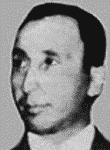Died New Orleans, LA, June 26, 1970.
"Silver Dollar Sam" Carollo (also spelled "Carolla") came to the United States as a young boy in early 1903. In his youth, he became affiliated with the regional Mafia organization run by Charles Matranga.
Carollo reportedly succeeded Matranga as boss of the organization upon Matranga's retirement in the 1920s.
Carollo, outwardly a restaurant manager, is believed to have participated in gambling, bootlegging and narcotics trafficking enterprises as well as New Orleans fishing, shrimping and dock work rackets.
He was convicted of a bootlegging-related offense in 1923 and was sentenced to a year and a day in Atlanta federal prison. He was paroled after serving a little more than eight months.
The year 1930 was an especially busy one for Carollo. He was arrested in February of that year for violation of the federal Harrison Narcotics Act and for shooting a federal agent. He also was suspected of murder, following the December 28, 1930, shooting death of William "Bill" Bailey.
He and co-defendant Frank Todaro served about a year and a half in Atlanta Federal Prison beginning in January 1931 on a narcotics conviction. They were released in spring 1932 by Atlanta federal Judge E. Marvin Underwood, though three additional consecutive six-month sentences remained on their prison terms. (Underwood voided the sentences on the rationale that federal prison incarcerations needed to be for at least a year and a day. He ordered that they be returned to New Orleans and resentenced to some other institution.)
For the attempted killing of a narcotics agent, Carollo received another eight- to fifteen-year sentence in 1933. That sentence was ended after one year by Louisiana Governor O.K. Allen's full pardon.
Just two years after the pardon, Carollo was once again a resident of Atlanta prison, having been sentenced to five years for another narcotics offense.
The federal government sought to deport Carollo in the early 1940s. Despite roadblock legislation introduced by Congressman James Morrison of Louisiana in order to keep Carollo in the U.S., officials succeeded in sending him back to Sicily in spring of 1947.
Louisiana and New York racketeers entered into lucrative agreements relating to casino and slot machine gambling during Carollo's reign.
Carollo's immediate successor in the New Orleans mob is uncertain. The government believed Carlos Marcello was in control of the family from about 1950 on, but there are suggestions that another boss worked behind the scenes until Marcello took the helm in the early 1960s.
The Carollo and Marcello families were joined through the marriage of Carollo's son Anthony and Marcello's niece Maria Zaniatta.
Carollo did not remain in Sicily for long. He was observed in Acapulco, Mexico, in 1949. He might have been attempting to run the New Orleans rackets from that location. Some claimed he was stationed there by Charlie Luciano as part of the worldwide drug trade. Carollo also was allegedly seen back in the New Orleans area as early as July 4, 1950. He and Salvatore "Kansas City Sam" Guarnieri, who also had been deported (twice), were found living in a luxuriously furnished hideout at Slidell, Louisiana. The property, 3701 Bruxelles, was owned by Carollo's daughter, Mrs. Sarah Misuraca. Carollo was again deported in 1951.
Years later, he again returned to the U.S. According to some sources, a rivalry developed between Carollo's son and Marcello's younger brother over who should succeed Marcello as New Orleans boss. There were rumors at the time that Marcello would elect to leave the country rather than serve a pending prison term. "Silver Dollar Sam" was reportedly called out of retirement to mediate the dispute. (A source told the FBI that the 1966 "Little Apalachin" assembly of gangland leaders at La Stella restaurant in New York followed a Mafia Commission meeting on the issue of the New Orleans succession.) Authorities determined that Carollo reentered the country through Detroit late in 1969.
Press accounts indicate that Carollo, back in the U.S. illegally, was briefly hospitalized at Touro Infirmary in New Orleans after a heart attack in February of 1970. After the hospital, he is believed to have stayed with family at 13544 Granville Street in New Orleans until his death. Federal authorities at the time were consider a third deportation.
Sources:
- Colarelli, SA Thomas L., "La Cosa Nostra," FBI report, file no. 92-6054-2387, NARA no. 124-10297-10121, Aug. 22, 1968, p. 1, 6.
- Kennedy, SA Regis L., "Carlos Marcello," FBI report, file no. 92-2713-61, NARA no. 124-10214-10018, Dec. 8, 1959, p. 11.
- SAC New Orleans, "Nofio Pecora," FBI memorandum, file no. 92-8100, NARA no. 124-90093-10057, Aug. 4, 1965, p. 14.
- "Carollo faces murder charge as victim of reprisal shooting dies," New Orleans Times-Picayune, Dec. 29, 1930, p. 1.
- "Prisoners fight new sentence in drug conviction," New Orleans Times-Picayune, April 16, 1932, p. 3.
- "Widespread raids net 13 arrests on narcotic charges," New Orleans Times-Picayune, Oct. 6, 1935, p. 1.
- "Alleged leader of big narcotic ring brought in," New Orleans Times-Picayune, Oct. 7, 1935, p. 1.
- "Carollo's method of entry interests federal agents," New Orleans Times-Picayune, July 7, 1950, p. 7.
- "Orleans jury indicts Carollo," New Orleans Times-Picayune, Feb. 28, 1970, p. 1.
- "Alleged Mafia leader expires," New Orleans Times-Picayune, June 27, 1970, p. 3.

